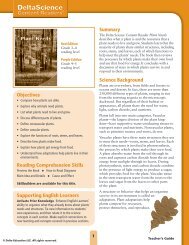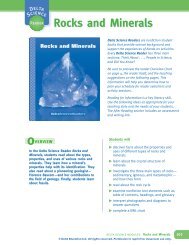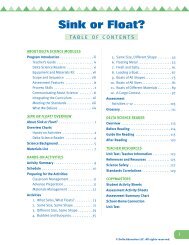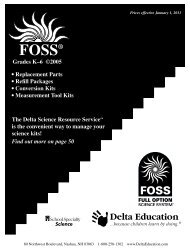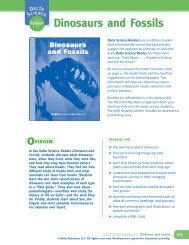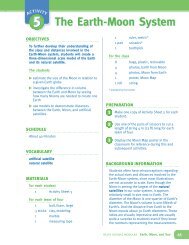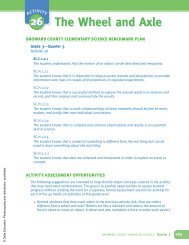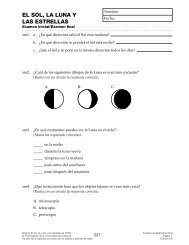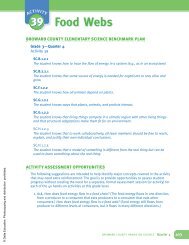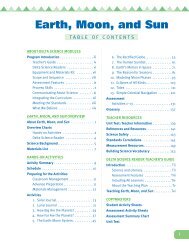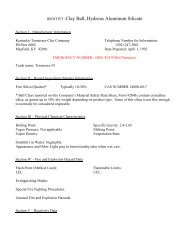Water Cycle Water Cycle - Delta Education
Water Cycle Water Cycle - Delta Education
Water Cycle Water Cycle - Delta Education
You also want an ePaper? Increase the reach of your titles
YUMPU automatically turns print PDFs into web optimized ePapers that Google loves.
<strong>Delta</strong><br />
Science<br />
Reader<br />
<strong>Water</strong> <strong>Cycle</strong><br />
<strong>Delta</strong> Science Readers are nonfiction student<br />
books that provide science background and<br />
support the experiences of hands-on activities.<br />
Every <strong>Delta</strong> Science Reader has three main<br />
sections: Think About . . . , People in Science,<br />
and Did You Know?<br />
Be sure to preview the reader Overview Chart<br />
on page 4, the reader itself, and the teaching<br />
suggestions on the following pages. This<br />
information will help you determine how to<br />
plan your schedule for reader selections and<br />
activity sessions.<br />
Reading for information is a key literacy skill.<br />
Use the following ideas as appropriate for your<br />
teaching style and the needs of your students.<br />
The After Reading section includes an assessment<br />
and writing links.<br />
O VERVIEW<br />
In the <strong>Delta</strong> Science Reader <strong>Water</strong> <strong>Cycle</strong>,<br />
students read about why Earth is called the<br />
water planet. They find out about salt water<br />
and fresh water and where each kind of<br />
water is found. They observe how water<br />
changes form by freezing, melting,<br />
evaporating, and condensing. They trace the<br />
water cycle and find out how heat energy<br />
from the sun is related to the water cycle.<br />
They learn how Earth’s weather is affected<br />
by the water cycle. They also read about<br />
Luke Howard, the scientist who first<br />
classified clouds. Finally, students<br />
investigate water as a natural resource.<br />
Students will<br />
find out that almost three-fourths of Earth’s<br />
surface is covered by water and that most<br />
of Earth’s water is the salt water in oceans<br />
and seas<br />
discover that fresh water is found on<br />
Earth’s surface, in the ground, in plants,<br />
and in the atmosphere<br />
understand the relationship between<br />
temperature and how water changes form<br />
through freezing, melting, evaporation, and<br />
condensation<br />
learn the stages of the water cycle and the<br />
role that it plays in the weather<br />
examine nonfiction text elements such as<br />
table of contents, headings, and glossary<br />
interpret photographs and diagrams to<br />
answer questions<br />
complete a KWL chart<br />
delta science modules <strong>Water</strong> <strong>Cycle</strong> 123<br />
© <strong>Delta</strong> <strong>Education</strong> LLC. All rights reserved. Permission to reprint for classroom use only.
READING IN THE<br />
CONTENT AREA SKILLS<br />
• Make and confirm predictions about<br />
sources of fresh water<br />
• Identify cause-and-effect relationships<br />
related to water’s changes of state<br />
• Compare and contrast the states of matter<br />
in which water can be found<br />
• Identify main ideas and supporting details<br />
in text sections<br />
• Describe the sequence of events in the<br />
movement of water through plants<br />
• Demonstrate critical thinking<br />
• Interpret graphic devices<br />
• Summarize<br />
NONFICTION TEXT ELEMENTS<br />
<strong>Water</strong> <strong>Cycle</strong> includes a table of contents,<br />
headings, photographs, illustrations, captions,<br />
boldfaced terms, diagrams, maps, labels, a<br />
chart, and a glossary.<br />
CONTENT VOCABULARY<br />
The following terms are introduced in context<br />
and defined in the glossary: absorb,<br />
atmosphere, cloud, condensation,<br />
desalination, estuary, evaporation, freeze,<br />
glacier, groundwater, humidity, iceberg,<br />
ice cap, irrigation, lake, melt, ocean,<br />
photosynthesis, porous, precipitation,<br />
resource, river, runoff, surface water,<br />
transpiration, water conservation, water cycle,<br />
water table, water treatment plant, water<br />
vapor, weather.<br />
Optional vocabulary: nonrenewable resource,<br />
renewable resource<br />
BEFORE READING<br />
Build Background<br />
Access students’ prior knowledge of the water<br />
cycle by displaying and discussing the cover.<br />
Ask, What do you see in this picture? (water,<br />
a lake, a shoreline with plants, ocean) What<br />
effects do you think bodies of water such<br />
as this have on our everyday lives? (Accept<br />
reasonable responses.)<br />
Read the title aloud, and invite students to<br />
share what they know about the topic from<br />
their personal experiences and hands-on<br />
explorations in science. To stimulate<br />
discussion, ask questions such as these:<br />
What is rain? What do you think causes<br />
rain? Where does the water in rain come<br />
from? Where can we find water? What are<br />
some ways that water changes?<br />
Begin a group KWL chart by recording facts<br />
students know about the water cycle in the K<br />
column and questions students have about<br />
the water cycle in the W column. You may<br />
want students to copy the KWL chart so they<br />
can maintain their own charts as they read.<br />
K<br />
What<br />
I Know<br />
W<br />
What<br />
IWant<br />
to Know<br />
Preview the Book<br />
L<br />
What<br />
I Learned<br />
+<br />
What<br />
I Want to<br />
Explore<br />
Further<br />
Explain that when students preview<br />
nonfiction, they should look at the title, the<br />
table of contents, headings, boldfaced words,<br />
photographs, illustrations, charts, graphics,<br />
and captions.<br />
Then preview the book with students. Call<br />
attention to the various nonfiction text<br />
elements and explain how they can help<br />
students understand and organize what they<br />
124 delta science reader<br />
© <strong>Delta</strong> <strong>Education</strong> LLC. All rights reserved.
ead. Ask questions such as these: How do<br />
the headings help you predict what you will<br />
read about? What do you see in this<br />
picture? How do you think it will help you<br />
understand the text? Explain that the words<br />
in boldface type are important words related<br />
to the water cycle. Point out that these words<br />
are defined in the glossary. Choose one word<br />
and have students find its definition in the<br />
glossary.<br />
Preview the Vocabulary<br />
You may wish to preview some of the<br />
vocabulary words before reading, rather than<br />
waiting to introduce them in the context of<br />
the book. Possibilities include creating a word<br />
wall, vocabulary cards, sentence strips, or a<br />
concept web.<br />
For example, some of the words can be<br />
categorized in multiple ways. With students,<br />
develop a word web such as the following.<br />
groundwater<br />
salt water<br />
GUIDE THE READING<br />
Preview the book yourself to determine the<br />
amount of guidance you will need to give for<br />
each section. Depending on your schedule<br />
and the needs of your class, you may wish to<br />
consider the following options:<br />
• Whole Group Reading Read the book<br />
aloud with a group or the whole class.<br />
Encourage students to ask questions and<br />
make comments. Pause as necessary to<br />
clarify and assess understanding.<br />
• Shared Reading Have students work in<br />
pairs or small groups to read the book<br />
together. Ask students to pause after each<br />
text section. Clarify as needed and discuss<br />
any questions that arise or have been<br />
answered.<br />
• Independent Reading Some students may<br />
be ready to read independently. Have them<br />
rejoin the class for discussion of the book.<br />
Check understanding by asking students to<br />
explain in their own words what they have<br />
read.<br />
Tips for Reading<br />
fresh water<br />
WATER<br />
ocean<br />
• If you spread out the reading over several<br />
days, begin each session by reviewing the<br />
previous day’s reading and previewing<br />
what will be read in the upcoming session.<br />
lake<br />
Set a Purpose<br />
river<br />
Beginning of concept web for water.<br />
Discuss with students what they might expect<br />
to find out from the book, based on their<br />
preview. Encourage them to use the questions<br />
on the KWL chart to set an overall purpose<br />
for reading.<br />
• Begin each text section by reading or having<br />
a volunteer read aloud the heading. Have<br />
students examine any illustrations or<br />
graphics and read accompanying captions<br />
and labels. Discuss what students expect to<br />
learn, based on the heading, illustrations,<br />
and captions.<br />
• Help students locate context clues to the<br />
meanings of words in boldface type.<br />
Remind them that these words are defined<br />
in the glossary. Provide help with words<br />
that may be difficult to pronounce.<br />
• As appropriate, model reading strategies<br />
students may find helpful for nonfiction:<br />
adjust reading rate, ask questions,<br />
paraphrase, reread, visualize.<br />
delta science modules <strong>Water</strong> <strong>Cycle</strong> 125<br />
© <strong>Delta</strong> <strong>Education</strong> LLC. All rights reserved.
Think About . . . (pages 2–12)<br />
Pages 2, 3 Why Is Earth Called the <strong>Water</strong><br />
Planet? and Salt <strong>Water</strong><br />
• Before students read, direct their attention<br />
to the photograph of Earth seen from<br />
space. Ask, What is the main feature of<br />
Earth that you see? (the oceans) Then<br />
have students read about the water planet.<br />
• Elicit main ideas about Earth and its water.<br />
Ask, What makes Earth the water planet?<br />
(Almost three-fourths of its surface is<br />
covered by water.) What is the most<br />
important idea—the main idea—you<br />
learned about the importance of water?<br />
(<strong>Water</strong> makes life on our planet possible.)<br />
What detail supports this main idea? (All<br />
living things need water to stay alive and<br />
healthy.) What are some of the ways in<br />
which we use water? (drinking, cooking,<br />
bathing, transportation, electrical power,<br />
water sports)<br />
• Have students read the body text on<br />
page 3 and look at the photographs and<br />
captions on pages 2 and 3. Ask, What<br />
kind of water covers most of Earth?<br />
(salty ocean water) What are the names<br />
of Earth’s four main oceans? (Pacific,<br />
Atlantic, Indian, Arctic) Direct attention to<br />
the map and guide students to recognize<br />
that the oceans are all connected.<br />
• Ask, What is the most interesting or<br />
surprising fact you learned about salt<br />
water? (Responses will vary, but students<br />
may mention the existence of saltwater<br />
lakes as a surprising fact.)<br />
• If necessary, provide help with the<br />
pronunciation of estuary (ES-chew-air-ee).<br />
Page 4 Fresh <strong>Water</strong> on Earth’s Surface<br />
• Have students read page 4 to learn about<br />
Earth’s surface water. Ask, Where is most<br />
of Earth’s fresh water? (frozen in glaciers,<br />
ice caps, and ice sheets) You might want<br />
to tell students that scientists estimate<br />
that if all of the ice in the glaciers and ice<br />
caps melted, the sea level would rise by<br />
about 80 meters (about 260 feet). Point<br />
out that water frozen in ice caps is not<br />
available to us, but people have been<br />
working on ways to harvest icebergs for<br />
their water.<br />
• Have students study the diagram at the<br />
bottom of page 4 and read the caption.<br />
Ask, Are you surprised to learn how little<br />
fresh water there is on Earth’s surface?<br />
Why or why not? (Responses will vary.)<br />
Encourage students to predict where else<br />
fresh water might be found.<br />
• If necessary, provide help with the<br />
pronunciation of glacier (GLAY-shur).<br />
Page 5 Fresh <strong>Water</strong> in the Ground<br />
• Before reading page 5, ask students<br />
whether any of them predicted that fresh<br />
water could be found in the ground. Have<br />
them confirm their predictions by reading<br />
the text about groundwater and studying<br />
the diagram.<br />
• Ask, How does water get into the ground?<br />
(<strong>Water</strong> from rain and melting snow and ice<br />
seeps into the soil and fills air spaces in<br />
soil and rock.) What are soils and rocks<br />
that can absorb water called? (porous)<br />
Point out that the word porous comes<br />
from pore, which means “opening.” Have<br />
students explain what the water table is.<br />
(<strong>Water</strong> spreads out in soil and rock and fills<br />
all the air spaces. The top level of that<br />
water is called the water table.)<br />
• Encourage students to speculate about<br />
what happens to the water table in<br />
periods when there is very little rain or<br />
snow. (It gets lower.)<br />
• If necessary, provide help with the<br />
pronunciation of porous (POR-us).<br />
Page 6 Fresh <strong>Water</strong> in Plants<br />
• Before students read page 6, ask, Did you<br />
predict that plants are a place where<br />
fresh water is stored? Have students read<br />
to confirm their predictions. Remind them<br />
126 delta science reader<br />
© <strong>Delta</strong> <strong>Education</strong> LLC. All rights reserved.
to study the diagram to help them<br />
understand the text.<br />
• After reading, ask, How do plants use<br />
water? (<strong>Water</strong> moves minerals and stored<br />
food to all parts of a plant. Plants mix<br />
water with carbon dioxide to make their<br />
own food.) What happens when plants do<br />
not get enough water? (They wilt and die.)<br />
• To test understanding, ask students to<br />
describe the sequence of events in the<br />
movement of water through a plant.<br />
(Groundwater is absorbed into the roots.<br />
It travels up the trunk or stem and into<br />
the leaves. There, water is used in<br />
photosynthesis to make food for the plant.<br />
<strong>Water</strong> that is not used by the plant goes<br />
into the air through tiny holes in the<br />
leaves.) What is this movement of<br />
water from a plant into the air called?<br />
(transpiration) How did the diagram help<br />
you understand the text? (It shows in<br />
picture form what the text explains with<br />
words.)<br />
• If necessary, provide help with the<br />
pronunciation of chlorophyll (KLOR-uh-fil),<br />
photosynthesis (fo-to-SIN-thuh-sis), and<br />
transpiration (tran-spuh-RAY-shuhn).<br />
Page 7 Fresh <strong>Water</strong> in the Atmosphere<br />
• Before having students read page 7, ask<br />
whether anyone predicted that some fresh<br />
water is found in the atmosphere, or air.<br />
Invite students to read page 7 to confirm<br />
their predictions.<br />
• Check comprehension by asking, What<br />
two forms does water in the atmosphere<br />
take? (One form is as a gas called water<br />
vapor. The other form is as water droplets<br />
or ice crystals in clouds.) Which of these<br />
forms can we see? Which are we unable<br />
to see? (We can see clouds, but we cannot<br />
see water vapor.)<br />
• Ask, What is humidity? (a measure of the<br />
amount of water vapor in the air) How<br />
would you describe the humidity today?<br />
Would you say that it is high or low?<br />
(Responses will vary.) What do you think<br />
causes the humidity to change? (Accept<br />
all ideas.) Explain that the amount of<br />
water vapor in the air changes with the<br />
temperature. More water evaporates into<br />
the air when it is warm, and more water<br />
condenses out of the air when it is cool.<br />
• If necessary, provide help with the<br />
pronunciation of atmosphere (AT-muhsfeer),<br />
humidity (hew-MID-ih-tee), and<br />
hygrometer (hi-GROM-uh-ter).<br />
Pages 8, 9 How <strong>Water</strong> Changes Form<br />
• Have students read the text about states of<br />
matter in the first column on page 8 and<br />
look at the accompanying photographs and<br />
labels. Check comprehension by having<br />
students summarize the information. (The<br />
three states of matter are solid, liquid, and<br />
gas. A solid has a shape of its own; a liquid<br />
and a gas do not. Ice is the solid form of<br />
water, water is the liquid form, and water<br />
vapor is the gas form.) Guide students to<br />
compare and contrast the three states of<br />
matter of water. Ask, How are ice, water,<br />
and water vapor alike? (They are all forms<br />
of water.) How are they different? (Ice has<br />
its own shape. <strong>Water</strong> and water vapor have<br />
no shape of their own. We can see water<br />
and ice, but we cannot see water vapor.)<br />
• Then have students read through the end<br />
of page 9 to discover how water changes<br />
form. Ask, What causes water to change<br />
form? (adding or taking away heat energy)<br />
What happens when enough heat energy<br />
is taken away from a liquid—water? (It<br />
becomes a solid—ice.) What causes a<br />
solid such as ice to turn back into a<br />
liquid? (adding heat) What is this process<br />
called? (melting) What is the effect of<br />
adding more heat to a liquid? (The liquid<br />
changes into a gas. <strong>Water</strong> becomes water<br />
vapor.) What is this process called?<br />
(evaporation) What causes water vapor to<br />
turn back into a liquid? (taking heat away;<br />
cooling it) What is this process called?<br />
(condensation) Discuss the examples of<br />
each process shown in the photographs.<br />
delta science modules <strong>Water</strong> <strong>Cycle</strong> 127<br />
© <strong>Delta</strong> <strong>Education</strong> LLC. All rights reserved.
• You may wish to tell students about two<br />
other changes of state for water: frost<br />
formation occurs when water changes<br />
directly from a gas to a solid, and<br />
sublimation is the direct change from<br />
solid to gas.<br />
• If necessary, provide help with the<br />
pronunciation of evaporation (ih-vap-uh-<br />
RAY-shuhn).<br />
Pages 10, 11 What Is the <strong>Water</strong> <strong>Cycle</strong>?<br />
• Before students read pages 10 and 11,<br />
write the word cycle on the board. Explain:<br />
The words cycle and circle are related.<br />
Just as you can run your finger around<br />
and around a circle, a cycle repeats<br />
itself in the same order. Brainstorm some<br />
other terms or words that contain cycle.<br />
(Students may suggest bicycle, tricycle,<br />
life cycle, cyclone.) Then ask, What do<br />
you think the water cycle might be?<br />
Before they answer, tell students to think<br />
about what they learned about how water<br />
changes form and what causes these<br />
changes. (Accept reasonable responses.)<br />
• Have students examine the diagram and<br />
read the caption and labels to confirm their<br />
ideas about the water cycle. Ask, How<br />
does water from Earth’s surface get into<br />
the air? (It evaporates.) What happens to<br />
water vapor in the air? (It condenses and<br />
forms clouds.) What do you see falling<br />
from the clouds? (rain) Where does the<br />
rain go? (It falls back down to Earth’s<br />
surface and into the ground.)<br />
• Then have students read the text on<br />
page 10 to determine what causes this<br />
cycle to take place. Ask, What is the<br />
water cycle? (the movement of water<br />
between Earth and the atmosphere and<br />
back again) To check comprehension of<br />
the water cycle, elicit the cause-and-effect<br />
sequence. Ask, What causes the water<br />
cycle to begin? (Heat energy from the sun<br />
warms Earth’s water and causes it to<br />
evaporate.) What happens to warm air in<br />
the atmosphere? (It cools and condenses<br />
back into water.) What is the effect of<br />
condensation? (Clouds form.) What<br />
causes the clouds to release their<br />
water? (The water droplets get larger<br />
and heavier.) What happens to the<br />
precipitation? (It returns to Earth,<br />
becomes surface water and groundwater,<br />
and the cycle starts again.)<br />
• Ask whether students were surprised to<br />
learn that the same water continually<br />
moves through the water cycle between<br />
Earth and the atmosphere. Invite students<br />
to explain why they were or were not<br />
surprised. Point out that the water we use<br />
today is the same water that has been on<br />
Earth since the oceans were formed on the<br />
planet several billion years ago. It all<br />
passes through the water cycle over and<br />
over again. Every day 1 trillion tons of<br />
water move through the water cycle.<br />
• Students may be interested to know that<br />
the water cycle was first suggested some<br />
2,500 years ago by a Greek scientist,<br />
Thales of Miletus (c. 625–550 B.C.E.)<br />
• If necessary, provide help with the<br />
pronunciation of precipitation (prih-sipih-TAY-shuhn).<br />
Page 12 Earth’s Weather<br />
• Have students read page 12 to discover<br />
how the water cycle affects the weather.<br />
Check comprehension by having students<br />
explain what causes changes in the<br />
atmosphere. (the heating and cooling of<br />
the land, water, and air) Ask, How do<br />
these changes affect the weather? (They<br />
cause changes in the temperature and in<br />
the amount of water vapor in the air. They<br />
affect cloud formation and precipitation.)<br />
• Have students look at the photographs<br />
and read the captions. Ask, What causes<br />
rain to fall? (<strong>Water</strong> droplets become too<br />
big and heavy to stay in the air.) What<br />
causes snow to fall instead of rain?<br />
(Cold temperatures keep the ice crystals<br />
that fall from clouds frozen all the way to<br />
the ground.) What is fog? (a cloud that is<br />
close to the ground)<br />
128 delta science reader<br />
© <strong>Delta</strong> <strong>Education</strong> LLC. All rights reserved.
• If appropriate, discuss the difference<br />
between weather and climate. Explain that<br />
weather refers to day-to-day conditions,<br />
such as rain, sunshine, wind, and snow.<br />
Climate refers to the average weather<br />
conditions in an area over a long period<br />
of time.<br />
People in Science (page 13)<br />
Luke Howard<br />
• Before they read, access students’ prior<br />
knowledge of clouds. Invite volunteers to<br />
share what they know about the different<br />
types of clouds and their names. Have<br />
students study the cloud photographs and<br />
read the captions. You may wish to have<br />
students look out the window to determine<br />
the types of clouds—if any—that are in the<br />
sky and what kind of weather they are a<br />
clue to. Then have students read page 13<br />
to learn about the man who first named<br />
and classified clouds.<br />
• Students may be interested to know that<br />
before 1800, clouds were often described<br />
as only “essences” floating in the sky. Their<br />
nature and causes were not understood.<br />
Ask, What conclusions can you draw from<br />
the fact that Howard’s system is still in<br />
use today? (Students may suggest that it is<br />
a useful system or that no better system<br />
has been suggested.)<br />
• If necessary, provide help with the<br />
pronunciation of cirrus (SEER-us), cumulus<br />
(KEW-myuh-lus), and stratus (STRAT-us).<br />
Further Facts<br />
• Luke Howard is regarded as the father of<br />
meteorology, the science that deals with<br />
the atmosphere, especially the weather.<br />
• Howard’s interest in the skies was<br />
stimulated by the brilliant sunrises and<br />
sunsets and incredible skies of 1783,<br />
when he was eleven. Violent volcanic<br />
eruptions in Iceland and Japan had sent<br />
clouds of dust and ash into the air,<br />
causing unusual atmospheric effects in<br />
the Northern Hemisphere that lasted from<br />
May through August.<br />
• Howard kept a daily record of his<br />
meteorological observations for more than<br />
thirty years.<br />
• “Notes on the Modifications of the<br />
Clouds,” in which Howard presented<br />
his cloud classification system, was<br />
illustrated with Howard’s own watercolors<br />
when it was published in 1803. Many of<br />
Howard’s sketches can be viewed online.<br />
• Howard later added a fourth category of<br />
clouds—nimbus (the Latin word for<br />
“rain”)—to identify clouds from which rain<br />
was falling.<br />
Did You Know? (pages 14–15)<br />
<strong>Water</strong> Is a Resource<br />
• Before they read pages 14–15, invite<br />
students to guess how much water the<br />
average person in the United States uses<br />
each day. Record guesses on the board.<br />
Then have students read to find out about<br />
water as a resource.<br />
• After they read, ask, Other than<br />
household use, in what ways is water a<br />
natural resource? (Dams change energy<br />
from moving water into electricity; water is<br />
used for irrigation on farms; most drinking<br />
water comes from groundwater; many<br />
foods we eat, such as fish and shellfish,<br />
live in water.)<br />
• Ask, How do people affect our water<br />
supply, according to the text? (<strong>Water</strong> can<br />
be polluted by chemicals and fertilizers.<br />
Paved areas prevent water from entering<br />
the groundwater, which lowers the water<br />
table.) You may wish to discuss other<br />
ways water is affected by people’s actions,<br />
such as these: Evaporation behind dams<br />
adds water vapor to the atmosphere.<br />
Irrigation canals divert water from one<br />
place to another, causing drought where<br />
the water once flowed naturally. Wells<br />
lower the water table.<br />
delta science modules <strong>Water</strong> <strong>Cycle</strong> 129<br />
© <strong>Delta</strong> <strong>Education</strong> LLC. All rights reserved.
• You may wish to introduce the concept of<br />
renewable and nonrenewable resources.<br />
Renewable resources are resources that<br />
are either available in unlimited supply or<br />
that are constantly being replaced or<br />
replenished. The sun and wind are limitless<br />
renewable resources; forests are a<br />
renewable resource that can be replaced.<br />
Nonrenewable resources cannot be<br />
replaced once they are used. Coal, oil, and<br />
natural gas are examples of such resources.<br />
They will eventually be used up. Ask<br />
students which kind of resource they think<br />
water is and why. (<strong>Water</strong> is a renewable<br />
resource; water keeps moving through the<br />
water cycle being used again and again.)<br />
• Discuss the chart of water use with<br />
students. Encourage students to share<br />
their reactions to the amounts of water<br />
used for each activity and the estimated<br />
daily use presented on page 15. Stimulate<br />
discussion by asking questions such as<br />
these: What is the most surprising fact<br />
you learned about water use? Will<br />
knowing this information change the<br />
way you use water? What changes can<br />
you make to use less water?<br />
• If necessary, provide help with the<br />
pronunciation of desalination (de-sal-ih-<br />
NAY-shuhn).<br />
AFTER READING<br />
Summarize<br />
Complete the KWL chart you began with<br />
students before reading by asking them to<br />
share the answers to their questions. Call on<br />
volunteers to retell each text section. Then<br />
have students use the information in the KWL<br />
chart to write brief summary statements.<br />
Discuss with students how using the KWL<br />
strategy helped them understand and<br />
appreciate the book. Encourage them to<br />
share any other reading strategies that<br />
helped them understand what they read.<br />
Direct attention to the fourth column in the<br />
chart and ask, What questions do you still<br />
have about the water cycle? What would<br />
you like to explore further? Record students’<br />
responses. Then ask, Where do you think<br />
you might be able to find this information?<br />
(Students might mention an encyclopedia,<br />
science books, and the Internet.) Encourage<br />
students to conduct further research.<br />
Review/Assess<br />
Use the questions that follow as the basis for<br />
a discussion of the book or for a written or<br />
oral assessment.<br />
1. What are the two kinds of water on Earth?<br />
(salt water, fresh water) Where is each type<br />
found? (Salt water is found in oceans and<br />
saltwater lakes. Fresh water is found in<br />
glaciers, ice caps, lakes, ponds, rivers, the<br />
ground, plants, and the atmosphere.)<br />
2. What are the three states of matter of<br />
water? (ice, a solid; water, a liquid; and<br />
water vapor, a gas) How does water change<br />
state? (<strong>Water</strong> changes state when heat is<br />
added or removed. Heating solid ice causes<br />
it to melt and change to a liquid. Heating<br />
liquid water causes it to evaporate to a gas.<br />
Cooling water vapor makes it condense to a<br />
liquid. Cooling liquid water to the freezing<br />
point makes it freeze to solid ice.)<br />
3. How does the water cycle affect the<br />
weather? (Changes in the water cycle cause<br />
changes in the atmosphere. This causes<br />
changes in the weather, such as the<br />
amount of clouds or precipitation.)<br />
Writing Links/Critical Thinking<br />
Present the following as writing assignments.<br />
1. Describe the stages in the water cycle, and<br />
tell why the water cycle is important. (<strong>Water</strong><br />
on Earth is warmed by the sun and turns<br />
into water vapor. In the air, water vapor<br />
condenses and forms clouds. <strong>Water</strong> droplets<br />
in clouds fall to Earth as precipitation. Then<br />
the cycle starts again. Students’ ideas about<br />
the importance of the water cycle will vary<br />
but should include that it allows us to use<br />
the same water over and over and that it<br />
affects Earth’s weather.)<br />
130 delta science reader<br />
© <strong>Delta</strong> <strong>Education</strong> LLC. All rights reserved.
2. Luke Howard studied something other<br />
people had not thought worth studying—<br />
clouds. As a result, he made important<br />
discoveries about the relationship between<br />
clouds and weather. If you could spend<br />
time studying something other people have<br />
not paid much attention to, what would<br />
you choose? Why? (Responses will vary.)<br />
Science Journals: You may wish to have<br />
students keep the writing activities related to<br />
the <strong>Delta</strong> Science Reader in their science<br />
journals.<br />
References and Resources<br />
For trade book suggestions and Internet sites,<br />
see the References and Resources section of<br />
this teacher’s guide.<br />
delta science modules <strong>Water</strong> <strong>Cycle</strong> 131<br />
© <strong>Delta</strong> <strong>Education</strong> LLC. All rights reserved.



